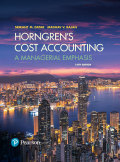
Cost-plus and market-based pricing. (CMA, adapted) Precision Laboratories evaluates the reaction of materials to extreme increases in temperature. Much of the company’s early growth was attributable to government contracts, but recent growth has come from expansion into commercial markets. Two types of testing at Precision are Heat Testing (HTT) and Arctic-Condition Testing (ACT). Currently, all of the budgeted operating costs are collected in a single
Jeff Boone, Precision’s controller, believes that there is enough variation in the test procedures and cost structure to establish separate costing rates and billing rates at a 40% markup. He also believes that the inflexible rate structure the company is currently using is inadequate in today’s competitive environment. After analyzing the company data, he has divided operating costs into the following three cost pools:
| Labor and supervision | $ 500,000 |
| Setup and facility costs | 300,000 |
| Utilities | 360,000 |
| Total budgeted costs for the period | $1,160,000 |
Jeff Boone budgets 100,000 total test-hours for the coming period. Test-hours is also the cost driver for labor and supervision. The budgeted quantity of cost driver for setup and facility costs is 600 setup hours. The budgeted quantity of cost driver for utilities is 9,000 machine-hours.
Jeff has estimated that HTT uses 60% of the test-hours, 20% of the setup-hours, and half the machine-hours.
- 1. Find the single rate for operating costs based on test-hours, and the hourly billing rate for HTT and ACT. Required
- 2. Find the three activity-based rates for operating costs.
- 3. What will the billing rate for HTT and ACT be based on the activity-based costing structure? State the rates in terms of test-hours. Referring to both requirements 1 and 2, which rates make more sense for Precision?
- 4. If Precision’s competition all charge $19.50 per hour for arctic testing, what can Precision do to stay competitive?
Want to see the full answer?
Check out a sample textbook solution
Chapter 13 Solutions
EBK HORNGREN'S COST ACCOUNTING
- Please given answerarrow_forwardCost of goods sold on the schedule of cost of goods sold?arrow_forwardAn analyst has projected that a company will have assets of $9,000 at year-end and liabilities of $7,300. The analyst's projection of total owners' equity should be closest to: A. $1700 B. $2,000 C. $3,200arrow_forward
- How much is the adjusted cost of goods sold on the schedule of cost of goods sold ?arrow_forwardVogel Corporation's cost of goods manufactured last month was $147,000. The beginning finished goods inventory was $35,000 and the ending finished goods inventory was $48,000. Overhead was overapplied by $8,000. Any underapplied or overapplied manufacturing overhead is closed out to cost of goods sold. How much is the adjusted cost of goods sold on the Schedule of Cost of Goods Sold? Correct answerarrow_forwardWhy does measurement attribute selection affect reporting quality? a) Standards fit everything b) Single measures work universally c) Selection wastes time d) Different value bases serve varying information needsarrow_forward
- Vogel Corporation's cost of goods manufactured last month was $147,000. The beginning finished goods inventory was $35,000 and the ending finished goods inventory was $48,000. Overhead was overapplied by $8,000. Any underapplied or overapplied manufacturing overhead is closed out to cost of goods sold. How much is the adjusted cost of goods sold on the Schedule of Cost of Goods Sold?arrow_forwardWhat is the stock's current price ?arrow_forwardWhat is bright sportswear's net income for the yeararrow_forward
 Essentials of Business Analytics (MindTap Course ...StatisticsISBN:9781305627734Author:Jeffrey D. Camm, James J. Cochran, Michael J. Fry, Jeffrey W. Ohlmann, David R. AndersonPublisher:Cengage Learning
Essentials of Business Analytics (MindTap Course ...StatisticsISBN:9781305627734Author:Jeffrey D. Camm, James J. Cochran, Michael J. Fry, Jeffrey W. Ohlmann, David R. AndersonPublisher:Cengage Learning Cornerstones of Cost Management (Cornerstones Ser...AccountingISBN:9781305970663Author:Don R. Hansen, Maryanne M. MowenPublisher:Cengage Learning
Cornerstones of Cost Management (Cornerstones Ser...AccountingISBN:9781305970663Author:Don R. Hansen, Maryanne M. MowenPublisher:Cengage Learning Managerial AccountingAccountingISBN:9781337912020Author:Carl Warren, Ph.d. Cma William B. TaylerPublisher:South-Western College Pub
Managerial AccountingAccountingISBN:9781337912020Author:Carl Warren, Ph.d. Cma William B. TaylerPublisher:South-Western College Pub


